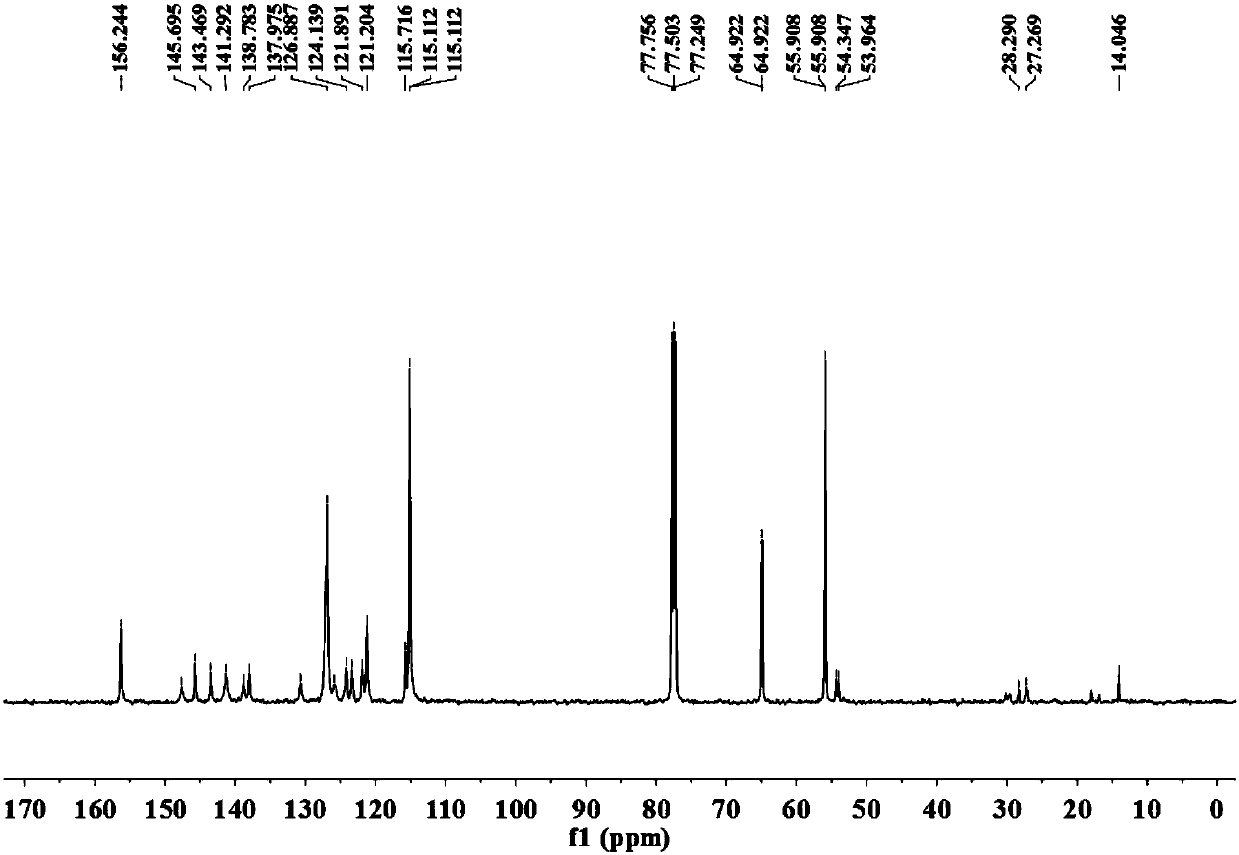Perovskite hole transport material based on triptycene mother nucleus and preparation method thereof
A hole-transporting material and perovskite technology, which is applied in semiconductor/solid-state device manufacturing, organic chemistry, electric solid-state devices, etc., can solve the problems of high synthesis cost of Spiro-MeOTAD, unfavorable commercial promotion, efficiency attenuation, etc., to achieve Excellent hole transport ability, good performance, and high thermal stability
- Summary
- Abstract
- Description
- Claims
- Application Information
AI Technical Summary
Problems solved by technology
Method used
Image
Examples
Embodiment 1
[0053] Embodiment one: 2,6,14-triptycene triiodide is synthesized
[0054]
[0055] (1) 2,6,14-Trinitrotriptycene 2
[0056] In a 250 mL two-necked flask, triptycene (5 g, 20 mmol) and concentrated nitric acid (65 wt%, 140 mL) were added. The mixed solution was heated to 70°C and reacted for 15 hours. After the reaction, the reaction solution was poured into 500 mL of ice water and stirred for half an hour. Then use a Buchner funnel to filter under reduced pressure, wash away the concentrated nitric acid with 1000 mL of ice water, and dry the filter cake to obtain a white solid. Dissolve the above solid in 50 mL of ethyl acetate, wash it twice with saturated brine, take the upper organic phase, add anhydrous magnesium sulfate to dry, filter, evaporate the solvent with a rotary evaporator, and then put it into the Vacuum oven overnight. The next day, the crude product was separated by chromatographic column with petroleum ether / ethyl acetate as eluent (3:1, v / v) to obtai...
Embodiment 2
[0061] Example 2: Synthesis of 4-bromo-N,N-bis(4-methoxyphenyl)aniline
[0062]
[0063] (1) 4-iodoanisole 6
[0064] In a 500mL double-necked flask, add 240mL methanol, 11.4mL concentrated sulfuric acid, ice bath for 15min, add anisole 5 (15mL, 0.14mol), and add potassium iodide (21.6g, 0.13mol) in 5 portions. Rise to room temperature, slowly add hydrogen peroxide aqueous solution (30wt%, 30mL) dropwise into the dropping funnel, raise the temperature to 55°C, stop the reaction after reacting overnight, cool to room temperature, extract with dichloromethane, and use 100mL saturated bisulfite Sodium wash twice. Add anhydrous sodium sulfate to the organic phase to dry, filter, and evaporate the solvent with a rotary evaporator. The crude product was recrystallized from methanol to obtain 6 as a white solid with a yield of 52%. Wherein the molar ratio of anisole: potassium iodide is 1:0.9. 1 H NMR (500MHz, CDCl 3 ) δ 7.56 (d, J = 8.9Hz, 2H), 6.68 (d, J = 8.9Hz, 2H), 3.78 ...
Embodiment 3
[0069] Example 3: Synthesis of 2-(tributyltin)-3,4-ethylenedioxythiophene
[0070]
[0071] Under nitrogen protection, 3,4-ethylenedioxythiophene 9 (4.0 g, 28.1 mmol) and dry tetrahydrofuran (100 mL) were added to a 250 mL Schlenk reaction flask. Nitrogen gas was continuously bubbled into the reaction solution, and it was cooled to -60°C. After 20 min, n-butyllithium solution (11.7 mL, 28.14 mmol, 2.4M n-hexane solution) was slowly added dropwise with a 20 mL syringe. After 2 hours, the dropwise addition was completed, and the temperature was continued for 15 minutes, and then slowly raised to room temperature. After stirring at room temperature for 2 h, the reaction solution was cooled to -60°C again, and after stirring for 20 min, tributyltin chloride (10 g, 31 mmol) was slowly added dropwise with a 20 mL syringe. Continue to stir at low temperature for 15 min after the dropwise addition, then slowly rise to room temperature, and stir overnight. The reaction was stoppe...
PUM
| Property | Measurement | Unit |
|---|---|---|
| Carrier mobility | aaaaa | aaaaa |
Abstract
Description
Claims
Application Information
 Login to View More
Login to View More - R&D
- Intellectual Property
- Life Sciences
- Materials
- Tech Scout
- Unparalleled Data Quality
- Higher Quality Content
- 60% Fewer Hallucinations
Browse by: Latest US Patents, China's latest patents, Technical Efficacy Thesaurus, Application Domain, Technology Topic, Popular Technical Reports.
© 2025 PatSnap. All rights reserved.Legal|Privacy policy|Modern Slavery Act Transparency Statement|Sitemap|About US| Contact US: help@patsnap.com



